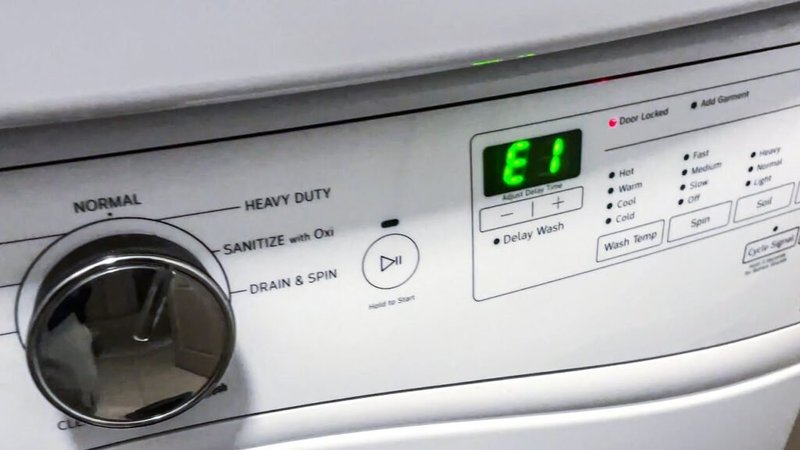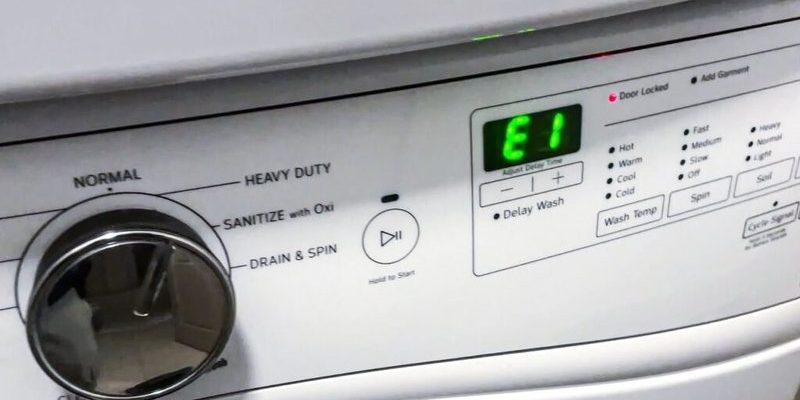
In simple terms, Error E1 indicates a problem with the water supply in your Whirlpool washing machine. It’s like when you’re trying to fill a cup with water, but someone accidentally turned the faucet off. The washing machine is essentially saying, “Hey, I need water to do my job, and I’m not getting any!” Ignoring this error might seem tempting, especially if the washer still seems to run okay. However, without addressing it, you could be risking larger issues down the road. Imagine continuously running a car low on oil; it might work for a bit, but eventually, the engine will face some serious problems.
Understanding Error E1: The Technical Side
Let’s dive into what Error E1 really means from a technical standpoint. You see, washing machines aren’t just about spinning clothes around in soapy water. They’re about precise water levels and timing, all controlled by a complex system of sensors and valves. When your Whirlpool washing machine displays Error E1, it means there’s a water inlet issue. The appliance thinks there’s a lack of water going into the drum, which could be due to several reasons like a blocked water inlet filter or a kinked hose.
Think of the water inlet as the washing machine’s lifeline. If it’s blocked or restricted, the machine can’t function properly, much like how you can’t breathe through a straw that’s pinched shut. The washer tries to fill up but can’t, causing it to display Error E1. It’s a protective measure designed to prevent further issues, as operating without adequate water can damage the machine’s components over time. Fixing this early could save you from more expensive repairs later on.
So, what can you do next? First, check if the water taps are fully turned on and that the hoses aren’t kinked or twisted. Sometimes, the simplest solutions are right in front of us, like untangling a stubborn knot in a pair of headphones. If everything seems normal, inspect the water inlet filter for debris or blockages. Cleaning this filter might solve the problem, restoring your washing machine to full working order.
The Consequences of Ignoring Error E1
You might be wondering, “What if I just ignore Error E1 and keep using my washer?” Well, here’s the deal: ignoring this error isn’t advisable. For starters, a persistent Error E1 means your washing machine isn’t operating at its best. It’s like wearing shoes that are too tight; you’ll get by for a while, but it’s bound to cause discomfort eventually. Over time, operating with an unresolved water inlet issue can lead to more severe problems.
One potential consequence is the damage to the washer’s internal components. The motor and pump rely on adequate water levels to function correctly. Without enough water, these parts can overheat and wear out faster, leading to costly repairs or even replacement of the entire machine. Moreover, your laundry might not be cleaned as effectively, resulting in clothes that are soapy or not rinsed properly.
There are also efficiency concerns to consider. A washer struggling with a water issue may use more electricity and water than necessary, which isn’t great for your utility bills or the environment. So, by addressing Error E1 promptly, you’re not only doing your machine a favor but also taking a small step towards more sustainable living.
Preventative Measures and Final Thoughts
So, how do you prevent Error E1 in the first place? It’s all about regular maintenance and care. Just like you wouldn’t neglect your car’s oil changes, don’t skip out on routine checks for your washing machine. Make it a habit to inspect the hoses and water inlet valves every few months. Ensure that the water supply is steady and that the inlet filters are clean and free of debris.
Consider this a friendly reminder that a little effort now can save you a lot of trouble later. Also, remember that your Whirlpool washing machine’s user manual is a great resource. It’s like having a cheat sheet for your appliance, providing troubleshooting tips and care instructions tailored to your model.
If you ever feel overwhelmed or unsure, don’t hesitate to reach out to a professional technician. They’re like the washing machine doctors, ready to diagnose and fix problems you might not feel comfortable tackling on your own. Taking these steps helps ensure your washer runs smoothly, keeping your laundry days stress-free. After all, no one wants to deal with piles of dirty laundry when it’s avoidable with just a bit of proactive care.
